Economy
Yeshwanthpur APMC: A Perfect Example of Fiscal Federalism At Work
M R Subramani
Mar 26, 2018, 02:28 PM | Updated 02:28 PM IST
Save & read from anywhere!
Bookmark stories for easy access on any device or the Swarajya app.

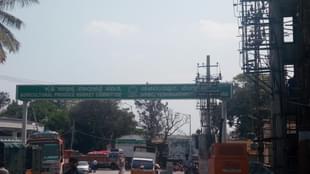
A agricultural produce market operates north-west of Bengaluru in Yeshwanthpur catering to nearly 2,000 farmers in villages surrounding the metropolitan city. These farmers bring in produce like onion, potato, groundnut mainly to this Yeshwanthpur Agricultural Produce Marketing Committee (APMC) yard. Growers also bring in other produce like coconut, tomato, while the APMC acts as a secondary market for pulses and other produces.
The APMC yard, spread over 85 acres, is one perfect example of how fiscal federalism is at work in the country, especially through agriculture. The Yeshwanthpur APMC Yard allows trading in 92 notified commodities by the Union government. Not all commodities are traded here, though. But trading of various commodities in this market, that helps Bengaluru residents get their daily supply of commodities, fetches income for the yard itself, the Karnataka State Agricultural Marketing Board and the Karnataka government.
Authorities at the yard say that the it fends for itself to meet most of its needs, especially development from the various fees that it charges. The market has a good security system that keeps track of all the commodities coming into the market and goods that go out after sale. Since onion and potato are the main commodities traded live through open outcry system at this yard, the APMC levies a one per cent market fee. For other commodities such as pulses and grains, the fee is 1.5 per cent.
Besides the user fee, the APMC yard levies user fee and licence fee besides charges for cold storages and warehousing facilities. The yard also collects market cess from those who bring their produce from other states. All these charges have helped the yard to double its income between 2011-12 and 2016-17. A fall in prices of commodities such as wheat, maize and pulses has resulted in its income dropping during 2014-15 and 2016-17.
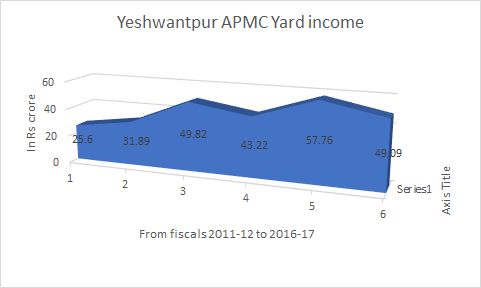
According to market officials, the APMC yard received Rs 20 crore as market fee in 2011-12, which increased to Rs 26.43 crore the following year before peaking at Rs 44.26 crore in 2013-14. In 2014-15, the market fee collection fell to Rs 24 .67 crore as prices of commodities crashed before recovering to Rs 33.47 crore and the Rs 35.14 crore the following years.
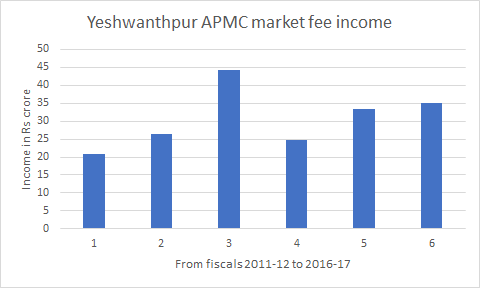
Among other income for the APMC yard are an annual licence fee of Rs 200 from the 1,584 commission agents. It also levies a similar fee on 1,807 traders on its rolls. There are some 100 importer and exporters registered with it and they pay an annual fee of Rs 100. Some 216 processors are registered and they too pay an annual fee of Rs 100 as also the 248 stockists in the yard. Over 1,000 retail traders pay a meagre annual licence fee of Rs 25, while nearly 400 hamals or load workers and another 19 weighmen pay Rs 10 as annual licence fee.
So how are the revenues generated by APMC yards utilised? Officials at the mandi say that 30 per cent of the revenue generated is utilised to service the state consolidated fund. It helps the state pay salaries to the government staff working in the market yard. Six per cent of the income is paid to the State Agricultural Marketing Board, including one per cent to agricultural universities for undertaking research to help the APMC yard provide better service. The remaining 64 per cent is utilised by the yard for its development, maintenance and service loans that it had taken earlier from banks for its developmental works.
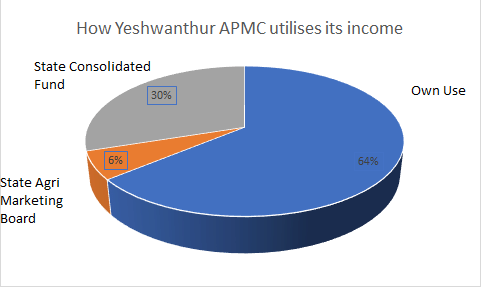
“We have availed of loans for works to develop our markets like internal roads or constructing guest houses or providing civic amenities. We pay back from the income we generate,” an official said on conditions of anonymity.
The APMC provides facilities like banking, godowns, a police station, free medical services, cold storages, auction platforms, cleaning and security. All these are serviced from its internal resources, generated from various fee collected by it.
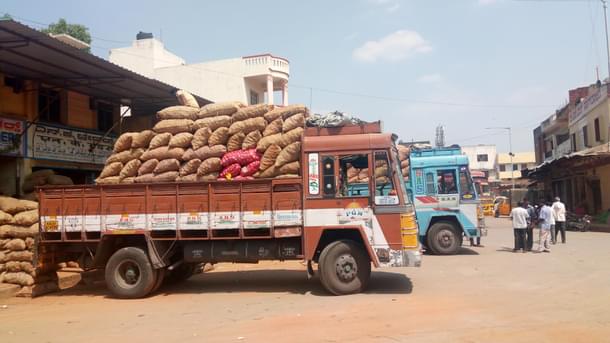
Officials said that the APMC’s income is sometimes used for market intervention operations like paying minimum support price to farmers for crops like maize and pulses. In the last few years, the APMC yard had helped the state government procure maize and pulses at minimum support price. The APMC also pays a fee of 20 paise per Rs 100 trade to the Rashtriya E Market Services Private Ltd for the software it uses for trading.
Asked about the Centre’s role in helping the APMC yard develop, the authorities said that they get funding under the Rashtriya Kisan Vikas Yojana, a programme to help agricultural development strategies including storage and warehousing. However, funding for the APMC yards are decided by the respective state governments.
But then, the fiscal management of the APMC is well defined and clear. Federal and state laws are in place for the yard to generate its own income. The revenue so generated is utilised to develop the market, remit a portion to the government for salary payment and give some to the agricultural marketing board for its activities.
M.R. Subramani is Executive Editor, Swarajya. He tweets @mrsubramani





